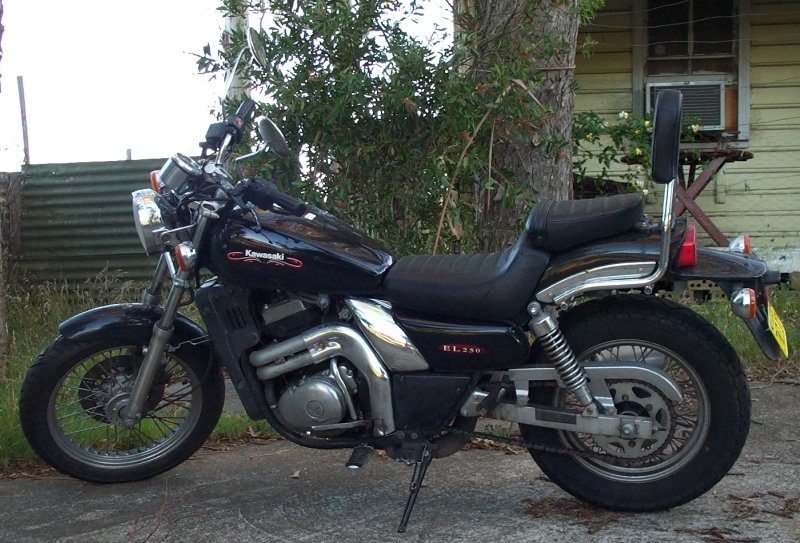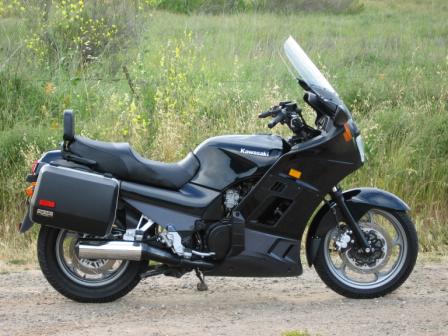|
Kawasaki Eliminator
The Kawasaki Eliminator is a cruiser-type motorcycle that has been produced in several variants since its introduction in 1985 as the 900 Eliminator. Currently billed as a "power cruiser", the first two versions of the bike, namely the 1985 Eliminator and 1986 ZL900 models, were almost street replicas of a drag style bike, featuring shaft drive, the ZX900 close-ratio gearbox and forward seating. The engine for both of these machines was the same motor available in the 900ccm Ninja of the same year, albeit with different exhaust and intake configurations. Available in black for 2005, the Eliminator 125's styling features include a stepped seat with laid-back riding comfort for two, a stretched 3.4-gallon fuel tank, straight-flow exhaust and chrome-plated single headlight. Models ZL900 Introduced in 1985, and only produced for 2 years. It was produced as the ZL900 A1 Eliminator in 1985 and the ZL900 A2 in 1986, the ZL900 evolved from the Kawasaki GPZ900R. The ZL900 was designed to ... [...More Info...] [...Related Items...] OR: [Wikipedia] [Google] [Baidu] |
Kawasaki ELIMINATOR EL250 01
Kawasaki ( ja, 川崎, Kawasaki, river peninsula, links=no) may refer to: Places *Kawasaki, Kanagawa, a Japanese city **Kawasaki-ku, Kawasaki, a ward in Kawasaki, Kanagawa **Kawasaki City Todoroki Arena **Kawasaki Stadium, a multi-sport stadium *Kawasaki, Fukuoka, a Japanese town *Kawasaki, Iwate, a Japanese village *Kawasaki, Miyagi, a Japanese town * Tokyo-Yokohama-Kawasaki, Japanese conurbation Transportation *Kawasaki Route ( ja, 川崎線, Kawasaki-sen, links=no), a toll road of the Shuto expressway system in Greater Tokyo *Kawasaki line, several lines *Kawasaki station, several stations Businesses *Kawasaki Heavy Industries (KHI), a Japanese manufacturer of aerospace equipment, ATVs, engines, industrial plants, motorcycles, jet skis, ships, tractors, trains and so on **Kawasaki Heavy Industries Motorcycle & Engine, a division of Kawasaki Heavy Industries ***Kawasaki motorcycles ***Kawasaki Motors Racing, the European subsidiary of Kawasaki Heavy Industries **Kawasaki Shipbui ... [...More Info...] [...Related Items...] OR: [Wikipedia] [Google] [Baidu] |
Kawasaki Motorcycle Corporation
Kawasaki Heavy Industries Motorcycle & Engine Company (川崎重工業モーターサイクル&エンジンカンパニー) is a division of Kawasaki Heavy Industries that produces motorcycles, ATVs, utility vehicles, jet ski personal watercraft, and general-purpose petrol engines. Before the 2011 fiscal year it was called Consumer Products & Machinery. Its slogan is "Let the good times roll!" Motorcycles Kawasaki's Aircraft Company began the development of a motorcycle engine in 1949. The development was completed in 1952 and mass production started in 1953. The engine was an air-cooled, 148 cc, OHV, four-stroke single cylinder with a maximum power of at 4,000 rpm. In 1954, the first complete Kawasaki Motorcycle was produced under the name of Meihatsu, a subsidiary of Kawasaki Aircraft. In 1960, Kawasaki completed construction of a factory dedicated exclusively to motorcycle production and bought Meguro Motorcycles. All-terrain vehicles and utility vehicles Kawa ... [...More Info...] [...Related Items...] OR: [Wikipedia] [Google] [Baidu] |
Cruiser (motorcycle)
A cruiser motorcycle is a motorcycle in the style of American machines from the 1930s to the early 1960s, including those made by Harley-Davidson, Indian, Excelsior and Henderson. The riding position usually places the feet forward and the hands up, with the spine erect or leaning back slightly. Typical cruiser engines emphasize easy rideability and shifting, with plenty of low-end torque but not necessarily large amounts of horsepower, and are traditionally V-twins, but inline engines have become more common. Cruisers with greater performance than usual, including more horsepower, stronger brakes and better suspension, are often called power cruisers. Japanese companies began producing models evocative of the early cruisers in the mid-1980s, and by 1997 the market had grown to nearly 60 percent of the US market, such that a number of motorcycle manufacturers including BMW, Honda, Moto Guzzi, Yamaha, Suzuki, Triumph and Victory have currently or have had important models e ... [...More Info...] [...Related Items...] OR: [Wikipedia] [Google] [Baidu] |
V-Twin
A V-twin engine, also called a V2 engine, is a two-cylinder piston engine where the cylinders share a common crankshaft and are arranged in a V configuration. Although widely associated with motorcycles (installed either transversely or longitudinally), V-twin engines have also been used for industrial engines and in several small cars. The V-twin design dates back to the late 1880s. Origins One of the first V-twin engines was built by Gottlieb Daimler in 1889. It was used as a stationary engine, for boats and in the Daimler Stahlradwagen ("steel-wheeled car"), Daimler's second car. The engine was also manufactured under licence in France by Panhard et Levassor. An early V-twin engined motorcycle was produced in November 1902 by the Princeps AutoCar Company in the United Kingdom. The following year, V-twin motorcycles were produced by Eclipse Motor & Cycle Co in the United Kingdom (the ''XL-ALL'' model), Glenn Curtiss in the United States, and NSU Motorenwerke in Ger ... [...More Info...] [...Related Items...] OR: [Wikipedia] [Google] [Baidu] |
Parallel-Twin
A straight-twin engine, also known as an inline-twin, vertical-twin, or parallel-twin, is a two-cylinder piston engine whose cylinders are arranged in a line along a common crankshaft. Straight-twin engines are primarily used in motorcycles; other uses include automobiles, marine vessels, snowmobiles, Jet Skis, all-terrain vehicles, tractors and ultralight aircraft. Various different crankshaft configurations have been used for straight-twin engines, with the most common being 360 degrees, 180 degrees and 270 degrees. Terminology The straight-twin layout is also referred to as "parallel-twin", "vertical-twin" and "inline-twin". Some of these terms originally had specific meanings relating to the crankshaft angle or engine orientation, however they are often also used interchangeably. In the United Kingdom, the term "parallel-twin" is traditionally used for engines with a crankshaft angle of 360 degrees, since the two pistons are in the same direction (i.e. parallel to each o ... [...More Info...] [...Related Items...] OR: [Wikipedia] [Google] [Baidu] |
Single-cylinder Engine
A single-cylinder engine, sometimes called a thumper, is a piston engine with one cylinder. This engine is often used for motorcycles, motor scooters, go-karts, all-terrain vehicles, radio-controlled vehicles, portable tools and garden machinery (such as lawnmowers, cultivators, and string trimmers). Single-cylinder engines are made both as 4-strokes and 2-strokes. Characteristics Compared with multi-cylinder engines, single-cylinder engines are usually simpler and compact. Due to the greater potential for airflow around all sides of the cylinder, air cooling is often more effective for single cylinder engines than multi-cylinder engines. This reduces the weight and complexity of air-cooled single-cylinder engines, compared with liquid-cooled engines. Drawbacks of single-cylinder engines include a more pulsating power delivery through each cycle and higher levels of vibration. The uneven power delivery means that often a single-cylinder engine requires a heavier flywheel than ... [...More Info...] [...Related Items...] OR: [Wikipedia] [Google] [Baidu] |
Inline-4
A straight-four engine (also called an inline-four) is a four-cylinder piston engine where cylinders are arranged in a line along a common crankshaft. The vast majority of automotive four-cylinder engines use a straight-four layout (with the exceptions of the flat-four engines produced by Subaru and Porsche) and the layout is also very common in motorcycles and other machinery. Therefore the term "four-cylinder engine" is usually synonymous with straight-four engines. When a straight-four engine is installed at an inclined angle (instead of with the cylinders oriented vertically), it is sometimes called a slant-four. Between 2005 and 2008, the proportion of new vehicles sold in the United States with four-cylinder engines rose from 30% to 47%. By the 2020 model year, the share for light-duty vehicles had risen to 59%. Design A four-stroke straight-four engine always has a cylinder on its power stroke, unlike engines with fewer cylinders where there is no power stroke occu ... [...More Info...] [...Related Items...] OR: [Wikipedia] [Google] [Baidu] |
Motorcycle
A motorcycle (motorbike, bike, or trike (if three-wheeled)) is a two or three-wheeled motor vehicle steered by a handlebar. Motorcycle design varies greatly to suit a range of different purposes: long-distance travel, commuting, cruising, sport (including racing), and off-road riding. Motorcycling is riding a motorcycle and being involved in other related social activity such as joining a motorcycle club and attending motorcycle rallies. The 1885 Daimler Reitwagen made by Gottlieb Daimler and Wilhelm Maybach in Germany was the first internal combustion, petroleum-fueled motorcycle. In 1894, Hildebrand & Wolfmüller became the first series production motorcycle. Globally, motorcycles are comparably popular to cars as a method of transport. In 2021, approximately 58.6 million new motorcycles were sold around the world, fewer than the 66.7 million cars sold over the same period. In 2014, the three top motorcycle producers globally by volume were Honda (28%), Yama ... [...More Info...] [...Related Items...] OR: [Wikipedia] [Google] [Baidu] |
Kawasaki GPZ900R
The Kawasaki GPZ900R (also known as the ZX900A or Ninja 900) is a motorcycle that was manufactured by Kawasaki from 1984 to 2003. It is the earliest member of the Ninja family of sport bikes. The 1984 GPZ900R (or ZX900A-1) was a revolutionary design that became the immediate predecessor of the modern-day sport bike. Developed in secret over six years, it was Kawasaki's and the world's first 16-valve liquid-cooled inline four-cylinder motorcycle engine.Walker (2006) p. 172 The 908 cc four-cylinder engine delivered , allowing the bike to reach speeds of , making it the first stock road bike to exceed . Prior to its design, Kawasaki envisioned producing a sub-liter engine that would be the successor to the Z1. Although its steel frame, 16-inch front and 18-inch rear wheels, air suspension, and anti-dive forks were fairly standard at that time, the narrow, compact engine was mounted lower in the frame, allowing it to take Japanese superbike performance to a new level. Six month ... [...More Info...] [...Related Items...] OR: [Wikipedia] [Google] [Baidu] |
Kawasaki Concours
The Kawasaki Concours, known as the GTR1000 in some markets, is a 1,000 cc sport touring motorcycle manufactured between 1986 and 2006 by Kawasaki. In 2007 it was replaced by the larger displacement Concours 14, also known as the 1400GTR. ZG1000 Concours The Kawasaki Concours, known in Europe as the 1000GTR and in USA as the ZG1000, is a 997 cc, six speed, four cylinder, liquid-cooled sport touring motorcycle with shaft drive. The bike can reach speeds over , offers nimble handling and – with its full fairing, tall screen, twin locking panniers, and fuel capacity – is suited to cross-country two-up touring. Kawasaki introduced the Concours in 1986, based on their Ninja 900 and Ninja 1000R models. Key differences between the Ninja 1000R and the ZG1000 included 32 mm instead of 36 mm carburetors, less aggressively ramped cams, shaft drive, front and rear sub-frames, hard luggage, and full fairing. The Concours was introduced into the USA the ... [...More Info...] [...Related Items...] OR: [Wikipedia] [Google] [Baidu] |
Bajaj Auto
Bajaj Auto Limited () is an Indian multinational automotive manufacturing company based in Pune. It manufactures motorcycles, scooters and auto rickshaws. Bajaj Auto is a part of the Bajaj Group. It was founded by Jamnalal Bajaj (1889–1942) in Rajasthan in the 1940s. Bajaj Auto is the world's third-largest manufacturer of motorcycles and the second-largest in India. It is the world's largest three-wheeler manufacturer. In December 2020, Bajaj Auto crossed a market capitalisation of , making it the world's most valuable two-wheeler company. History Bajaj Auto was established on 29 November 1945 as M/s Bachraj Trading Corporation Private Limited. It initially imported and sold two- and three-wheelers in India. In 1959, it obtained a license from the Government of India to manufacture two-wheelers and three-wheelers and obtained Licence from Piaggio to manufacture Vespa Brand Scooters in India. It became a public limited company in 1960. With the launch of motorcycles in 198 ... [...More Info...] [...Related Items...] OR: [Wikipedia] [Google] [Baidu] |








